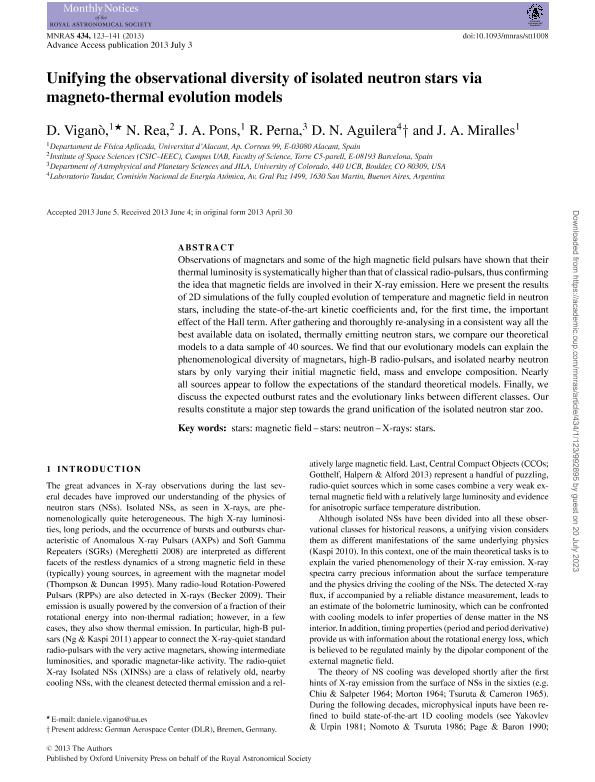Mostrar el registro sencillo del ítem
dc.contributor.author
Vigano, D.
dc.contributor.author
Rea, N.
dc.contributor.author
Pons, J. A.
dc.contributor.author
Perna, R.
dc.contributor.author
Aguilera, Deborah Nancy

dc.contributor.author
Miralles, J. A.
dc.date.available
2015-12-23T20:05:35Z
dc.date.issued
2013-06
dc.identifier.citation
Vigano, D.; Rea, N.; Pons, J. A.; Perna, R.; Aguilera, Deborah Nancy; et al.; Unifying the observational diversity of isolated neutron stars via magneto-thermal evolution models; Oxford University Press; Monthly Notices of the Royal Astronomical Society; 434; 1; 6-2013; 123-141
dc.identifier.issn
0035-8711
dc.identifier.uri
http://hdl.handle.net/11336/3228
dc.description.abstract
Observations of magnetars and some of the high magnetic field pulsars have shown that their thermal luminosity is systematically higher than that of classical radio-pulsars, thus confirming the idea that magnetic fields are involved in their X-ray emission. Here we present the results of 2D simulations of the fully coupled evolution of temperature and magnetic field in neutron stars, including the state-of-the-art kinetic coefficients and, for the first time, the important effect of the Hall term. After gathering and thoroughly re-analysing in a consistent way all the best available data on isolated, thermally emitting neutron stars, we compare our theoretical models to a data sample of 40 sources. We find that our evolutionary models can explain the phenomenological diversity of magnetars, high-B radio-pulsars, and isolated nearby neutron stars by only varying their initial magnetic field, mass and envelope composition. Nearly all sources appear to follow the expectations of the standard theoretical models. Finally, we discuss the expected outburst rates and the evolutionary links betweendifferent classes. Our results constitute a major step towards the grand unification of the isolated neutron star zoo.
dc.format
application/pdf
dc.language.iso
eng
dc.publisher
Oxford University Press

dc.rights
info:eu-repo/semantics/openAccess
dc.rights.uri
https://creativecommons.org/licenses/by-nc-sa/2.5/ar/
dc.subject
Magneto-Thermal Evolution
dc.subject
Neutron Stars
dc.subject
X-Ray Emission
dc.subject
Magnetars
dc.subject.classification
Astronomía

dc.subject.classification
Ciencias Físicas

dc.subject.classification
CIENCIAS NATURALES Y EXACTAS

dc.title
Unifying the observational diversity of isolated neutron stars via magneto-thermal evolution models
dc.type
info:eu-repo/semantics/article
dc.type
info:ar-repo/semantics/artículo
dc.type
info:eu-repo/semantics/publishedVersion
dc.date.updated
2016-03-30 10:35:44.97925-03
dc.journal.volume
434
dc.journal.number
1
dc.journal.pagination
123-141
dc.journal.pais
Reino Unido

dc.journal.ciudad
Oxford
dc.conicet.avisoEditorial
This article has been accepted for publication in Monthly Notices of the Royal Astronomical Society ©: 2013 The Authors Published by Oxford University Press on behalf of the Royal Astronomical Society. All rights reserved.
dc.description.fil
Fil: Vigano, D.. Universitat d’Alacant. Departament de Física Aplicada; España
dc.description.fil
Fil: Rea, N.. Consejo Superior de Investigaciones Científicas. Institut d; España
dc.description.fil
Fil: Pons, J. A.. Universitat d’Alacant. Departament de Física Aplicada; España
dc.description.fil
Fil: Perna, R.. University of Colorado. Department of Astrophysical and Planetary Sciences and JILA; Estados Unidos
dc.description.fil
Fil: Aguilera, Deborah Nancy. Comisión Nacional de Energía Atómica. Gerencia del Area de Investigación y Aplicaciones No Nucleares. Gerencia Física. (Centro Atómico Constituyentes) Proyecto Tandar; Argentina. Consejo Nacional de Investigaciones Científicas y Técnicas; Argentina
dc.description.fil
Fil: Miralles, J. A.. Universitat d’Alacant. Departament de Física Aplicada; España
dc.journal.title
Monthly Notices of the Royal Astronomical Society

dc.relation.alternativeid
info:eu-repo/semantics/altIdentifier/doi/http://dx.doi.org/doi:10.1093/mnras/stt1008
dc.relation.alternativeid
info:eu-repo/semantics/altIdentifier/url/https://academic.oup.com/mnras/article/434/1/123/992895
dc.relation.alternativeid
info:eu-repo/semantics/altIdentifier/url/http://arxiv.org/abs/1306.2156
Archivos asociados
